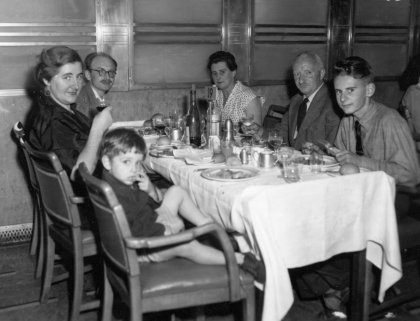
 |
|
Aboard
the Queen Mary on my journey to New York. My mother and father are behind
me, I do not know the other family on the right.
|
Me, myself
I am told my first word was car. There never really was any doubt that I loved movement and machinery, but this direction must have been clearly cemented in my mind by the earliest major experience of my life, visiting USA for 6 months. My father, Gerard Friedlander, was a mathematician, a junior lecturer at Manchester University at the time. He was offered a chance to spend six month doing research at New York University in 1954. I was two years old when I left and I returned thoroughly converted to the joys of all things big and mechanical. I remember the ship we sailed in, The Queen Mary, I remember standing on the quay with its vast dark presence beside me. In New York, it was the sky scrapers and the building sites, especially the excavators. I could not quite get my tongue around this word which I pronounced 'enterbator', and of course the cars. My dad drove a Dodge.
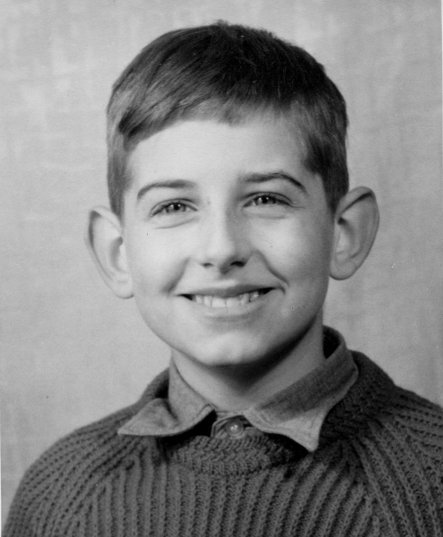 |
|
Stars
in my eyes? I had a fascination with space travel and astronomy from an
early age.
|
Shortly after returning to England, my father was offered a more senior post at Cambridge, which is where he ended up spending the rest of his academic career, going onto become a Fellow of the Royal Society. The best thing I remember about Cambridge as a small child was having an enormous garden which I would spend long hours down absorbed in my own fantasy world. The first time I understood about news on TV I was six years old. This was the beginning of the space age and the Russians had put Sputnik into space. I remember hearing the eerie electrical sound of its radio signals returning to Earth. I was totally in love with rockets and space travel. I dreamed that when I grew up I would invent a way to fly to the stars, build my own spaceship, and fly off by myself. In my garden, I constructed my own first attempts, made out of odds and ends, but in a funny sort of a way, looking back now, I see that this where I began to find the sculptor in me.
I was far from a conventional child. I am sure my school mates considered me strange. I had no interest in sports or team activities of any kind and looked different. As soon as the Beatles came out, I discovered music, which previously had been completely meaningless to me. Within months I started to grow my hair long. I was to become a rebellious teenager. In those days, England was mostly still very conventional. Those of us who dared to be different had to put up with the taunts of others. People would jeer at me in the street, shouting 'Is it a boy or a girl?' My unusual appearance caused problems at school, but I am glad to say my parents stood right behind me, defending my right to be different. They were in their own more reserved way unconventional themselves. My mother, Yolande Friedlander, was an artist, and although my father was an academic, he never liked the college life and the obsession with tradition which is so much part of that ancient city. To him it seemed totally illogical, and contrary to the spirit of pursuit of new ideas.
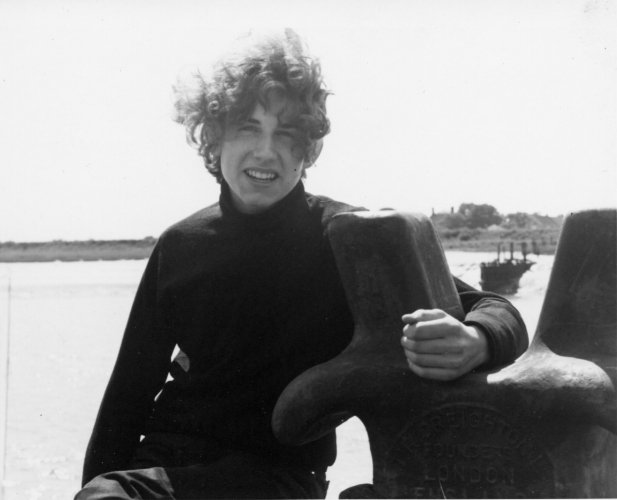 |
|
On
a trip to the Norfolk coast at Kings Lynn, posing on the quay beside a
suitably sculptural object. I remember we had just been to a small art
exhibition which inspired me to create a sculpture.
|
At secondary school I excelled at physics and mathematics. Although I had shown some talent in art, I really considered this a minor pursuit at the time. While still dreaming of space ships, I turned my attention to cosmology. That seemed a subject worth pursuing: the theory of the universe. At that time there were two competing ideas: the Big Bang Theory and The Steady State. I preferred The Steady State. I judged it much more logical. I did not like the idea that the universe could have begun only relatively recently in an incomprehensibly large explosion. I much preferred the notion of eternity. The universe was eternally old. There was no beginning and there would be no end. I still hold to that view but the history of cosmology turned another way, The Big Bang came to dominate, so by the time I arrived at university, I had some misgivings about following this direction, knowing that 'my' theory was losing out.
Shortly after arriving at university, ( I was reading physics and maths at Sussex), I went up to London for the day to visit an art exhibition. I had always visited art exhibitions since I was a small child. My mother would take us as children to see the visiting shows of contemporary work which regularly came to the small Arts Council gallery in Cambridge. What I was to see on that fateful day in London was no small exhibition. The show 'Kinetics' at the Hayward Gallery in 1970 was to change my life. I was totally in rapture from the experience. There were numerous marvelous pieces by all the leading kinetic artists. The work that struck me as the finest was by Nicholas Schoffer, a french cybernetic artist.
I came away from the show convinced that I knew now what I wanted to do with my life. I wanted to create kinetic art. I set about this without delay. I became enthusiastically involved in making kinetic works in my spare time. Very soon I found myself spending more time making art than working on my studies. I set up a simple workshop in my house and found a new way to live. Every morning I would get up and attend lectures. These would generally all be over by lunch time. In the afternoon, instead of going to the library to study, I would come home and work on my kinetics. I considered dropping out but chose to stay, although I am sure my studies did suffer as a result of my new found passion. Something of the scientific method rubbed off on me and I have never lost my love of science. I was particularly lucky at Sussex to to have as personal tutor, Anthony Leggett, a brilliant physicist and expert on quantum mechanics at low temperatures. He subsequently received the Nobel prize for work on superfluids.
After graduating, I chose to continue my studies, taking a degree in fine art. My mother had died by then, and I am very grateful to my father who continued to support me and give me encouragement in pursuing my new direction. I went to Exeter Art College, which turned out to be a disappointment. I hated the prevailing attitude in the art world. The teachers struck me as being fickle and often not very intelligent. My passion for my work continued but I was challenged now about what direction my career could take. There was apparently no interest in the art world for beauty. This was considered out of date, passe. Nothing could be worse than to be labeled passe and kinetics was rapidly going out. The big new thing was conceptualism. I came to consider the art world as some kind of strange fashion following cult. Members of the art world all shared the same views, talked nonsense and froze out any one who dared to consider their own talent more important than following what every one else was doing.
Arriving in London in 1977 after having finished all my studies, I found the most fabulous studio to work and live in. It was a huge old warehouse down by the river Thames next to Tower Bridge called Butler's Wharf. There were already about 150 artists there tucked into this warren of atmospheric old buildings. My place was on the waterfront, up on the fourth level, with great big double doors opening out over the quay. Despite this auspicious piece of luck in finding this wonderful place, I was really not sure what to do next with my life. I had fallen out of favour with the art world, and could not yet see where else to apply my talents. I decided to try developing some commercial products which I could licence to manufacturers in the entertainment industry. I was very naive in commercial matters. Although I took out a provisional patent on the idea, I was easily tricked by the company to whom I showed my invention. They pretended to have only a vague interest in what I was doing and then said they did not wish to pursue the matter. In reality they were busy behind my back, creating their own new lighting effect, inspired by what I had shown them. They were clever enough not to exactly copy what I did, so I could not easily take them to court, but I have no doubt that about what happened. Today there are numerous products on the market which all owe their origin to the prototypes I had created back then.
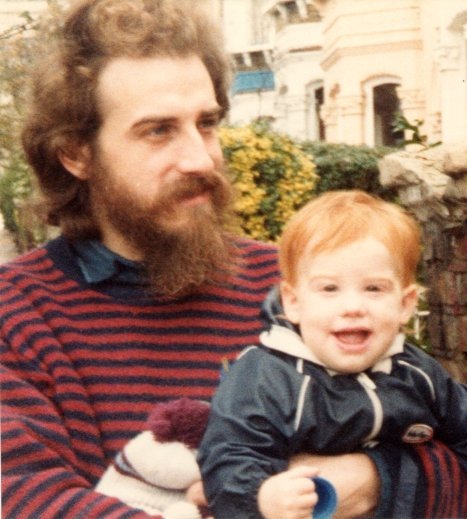 |
|
I
tried to become a quiet family man following my encounter with the world
of cults and people in pursuit of 'higher' knowledge.
|
A couple of years passed and when one day, an old acquaintance phoned up and asked if I would like to be the lighting director for a theatrical production, I jumped at the chance. The show was called 'The Warp', directed by Ken Campbell and written by Neil Oram. A 23 hour long cycle of plays to be performed with only brief intervals through the night and most of the following day, twice a week for three weeks at the Edinburgh Festival. This was 1979, and from then on I found myself drawn deeper into a world of very eccentric people. The Warp was an autobiographical play concerning an English mystic and nearly guru. It told the story of the life of a man who had started out in the beat era, inspired by poetry and jazz, gone onto experiment with drugs, particularly LSD, then turned to scientology, before heading off to India in search of enlightenment. Eventually ending up back in the UK, living in Scotland in a remote farm house he squatted on the shores of Loch Ness. Here he gathered around him a gang of seekers after knowledge. Some of these people went on to become members of the cast of the play, whilst a good proportion of the other actors, if not actually friends of the author were of a similarly mystical outlook.
I was never in any doubt about what I thought about such movements, but whilst I considered the ideas expressed to be nonsense, I found myself strangely drawn to the people. They seemed to have more sensitivity, more humanity, than the rest of the population. I was now in a kind of limbo state. I was neither a believer, nor was I straight. I had no interest in joining these strange movements, nor could I imagine where I could go next in life. What actually happened was more down to earth. I met someone, started a family, had two wonderful children, Naomi and Jack, and was completely devoted to them. Whilst the children were small, they took up most of my life. I continued to do stage lighting, but it was not an important part of my life. It was just something I did.
Deep down I was unsatisfied. My unconscious would not let me be at peace. There was something burning in me and it had to get out. I had a mission in life that I was failing to pursue it. My family life suffered, my relationship ended, and then I decided I could no longer stand doing stage lighting. I did not want a director telling me what he wanted. I wanted to decide what I wanted. I did my last professional stage lighting design in 1987. By then I had become known as a leading designer of lighting for avant-garde music. The last show was for the Electric Symphony Orchestra at Sadlers Wells Theatre. It was a good show but not my best. I was ready to move on.
Luckily I already had some ideas tucked away I had been working on for some years. Little maquettes, kinetic pieces, mostly no more than a few inches high crudely made out of electric motors, light bulbs and other bits of this and that. I had for some time been thinking about the problem of three dimensional projection. It had started out with a wish to create some kind of 3D projection which occupied the space we lived in. I had seen holograms, tried stereoscopic glasses and was unimpressed. These things felt like illusions. The 3D was never real enough. I wanted something that was simply there, in the room with me, not solid, but translucent, made of light, luminous, and capable of changing.
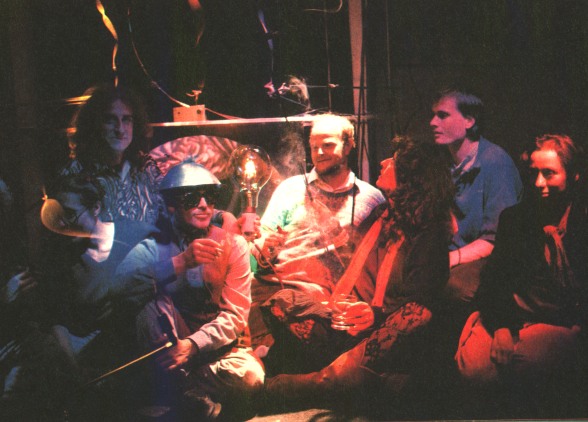 |
|
The
group of artists I brought together for a show on Chaos. We exhibited
together under the group name: 'Earth Signals'. The exhibition was very
popular.
|
Although these experiments were simple, I made two important discoveries. I discovered the chaotic properties of spinning string and chromastrobic light. I will not repeat a description of these phenomena here since they are well described elsewhere. What is important for you to understand that whilst I had focussed on my family and stage lighting, these ideas had languished in the back room. Now I decided it was time to focus on them. I built a small collection of sculptures, put together a group of artists interested in Chaos and organised an exhibition on that theme. This was the summer of 1990. Chaos was really 'in'. For once I was in fashion. It may have been a small show in a tiny gallery, but now I was getting written about, I appeared on TV. This began to feel like something was happening. I was not selling work. The art connoisseurs were not yet interested, but I was making waves.
About this time I received an invitation to attend a conference at the Massachusetts Institute of Technologies Institute of Advanced Visual Studies. I had always wanted to go there. This is a mecca for hi-tech artists so this was an opportunity not to be missed. The conference called Art Transition '90 was to prove a transition for me. It was now almost twenty years since I had first been so inspired by kinetic art and throughout all that time I had never lost my fascination for the subject, yet I had been so distracted by other pursuits that I had spent only a small part of those years following my interest. This conference coming hard on the heals of my recent show in London set me clearly on a path which I have followed ever since. No longer would I divide my time, I must live for my art. As luck would have it, amongst the other delegates, was a man already well skilled in commercialising art, Bill Parker, the inventor of the plasma ball. He loved my work from the first moment when he set eyes on it and offered to give me an introduction to the company who were manufacturing his product. For a while it looked like I was set to make a fortune. I flew off to Hong Kong and was put up in great luxury, all on the company expenses. A licence agreement was quickly signed and a product followed. Unfortunately USA was going into one of its many recessions at that time. No sooner was the product on the market than it was withdrawn again. Even though 30,000 pieces had been sold, it was not selling as well as the company had hoped. The company themselves were in trouble and they too went out of business shortly afterwards. I sold several more commercial licences around that time but I was not destined to make a fortune that way. None of my other designs went into production and I soon found myself again concentrating on creating art for arts sake.
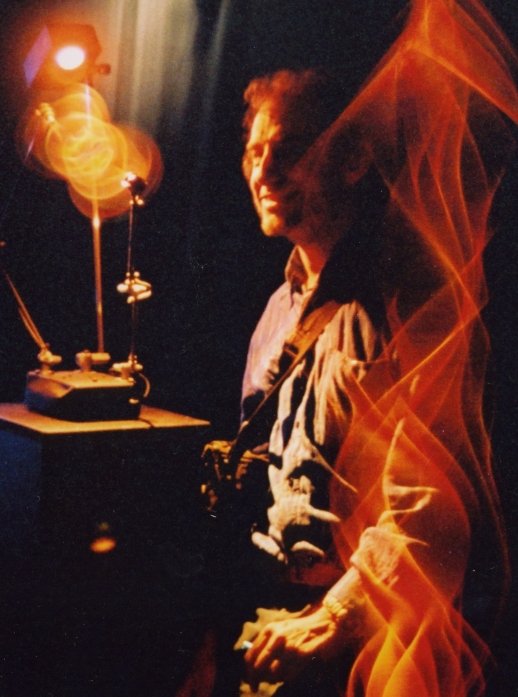 |
|
Seen
here amongst a group of sculptures on show at the VIA festival in Maubeuge,
northern, France.
|
In 1993, I was asked to do my first large commission for British Telecom at their HQ in the City of London. I was also invited to exhibit at Images du Futur in Montreal, where despite being a previously unknown, I was given the largest single exhibition space of any of the artists. My reputation for working on a big scale had arrived before me. Not many sculptors can claim to make really large sculptures. I can, and that really got noticed. Receiving the commission as well was a double success because that meant I was beginning to sell the work as well. Since that time, I have gradually found my reputation spreading further and further. You can find a full list of my major shows and commissions in my professional CV. I have received various prizes and won competitions. Most recently I have been listed in Who's Who for 2002. My most memorable experience was Lightforms '98 in New York. Today I have reached a point where I have to turn down offers I would like to accept simply because there is not enough time to do everything.
I still see myself on a mission. So far I have exhibited my light sculptures on numerous occasions but not much has been seen of my computer art. I have been a late starter in this field. I taught myself to program in 1996, learning the computer language, Delphi. My first achievement, Zip Art, I wrote within a matter of weeks of starting to program: it was initially intended as a learning exercise, but the project took on a life if its own. It has proved the most popular software I have written, thousands have copies of it have been downloaded from my website and unknown number of pictures drawn with it. You can find a copy of it on this CD. My primary goal was writing software to control light sculptures. This is the major part of my computer art, but I continue to write software which generates graphics. I do not use conventional graphics or animation. I prefer to write code. Recently I have used OpenGL and an example of this can be found on my website under Las Vegas.
My long term goal remains the full integration of the light sculptures with computer art leading to the creation of 3D projections.